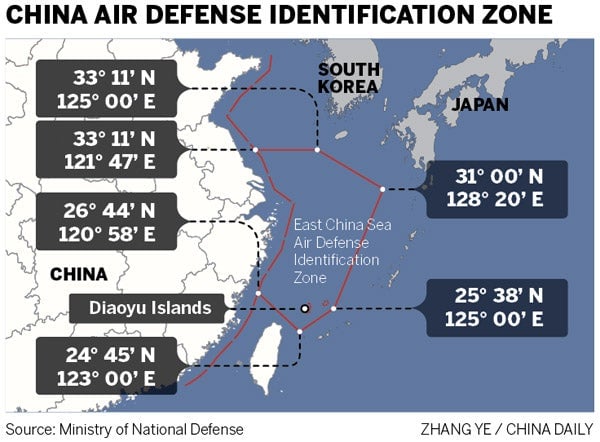China’s new air defense zone forces commercial airlines to weigh country against safety
China’s controversial new “air defense zone,” which overlaps with existing zones claimed by Japan and South Korea, presents commercial airlines with a knotty problem. Many countries balk at recognizing the zone as Chinese airspace, but China says that airlines flying through it must submit flight plans, stay in radio contact with Chinese authorities, and follow their instructions.


China’s controversial new “air defense zone,” which overlaps with existing zones claimed by Japan and South Korea, presents commercial airlines with a knotty problem. Many countries balk at recognizing the zone as Chinese airspace, but China says that airlines flying through it must submit flight plans, stay in radio contact with Chinese authorities, and follow their instructions.
Complying with China’s wishes effectively legitimizes China’s control of the area, and could encourage it to establish other zones of control, some security experts warn. “If foreign aircraft now regularly obey the new Chinese rules, we will see precedents set for the unilateral expansion of Chinese authority over contested maritime territory,” Rory Medcalf, an Asian security expert with the Lowy Institute, told the Financial Times (paywall). But he also acknowledges that if airlines don’t obey the rules they risk a “dangerous or deadly incident.”
Staying away entirely might be the best option. Doug Nancarrow, a licensed commercial pilot and the editor of Aviation Business, told Quartz his personal opinion is that “airlines would be wise to avoid the airspace in question.” Airlines “will well remember the Korean Airlines 747 that infringed Russian airspace,” he said, referring to a 1983 incident in which an off-course passenger jet was shot down by Soviet jet fighters, killing all 269 on board.
The zone covers an area estimated at around two-thirds the size of the United Kingdom, and includes a submerged island controlled by South Korea and the disputed Senkaku Islands, which are claimed by both Japan and China.

Air traffic through the area, particularly in and out of Japan, is constant. Here’s a look at just the flights going to and from Tokyo’s international Narita Airport at around 4pm local time on Nov. 28:

Japanese airlines ANA and Japan Airlines said at first they would comply with China’s demands and submit flight plans, but later reversed themselves after the Japanese government told them not to. Singapore Airlines, Qantas Airways and Korean Air said they would give China flight plans, but South Korea’s government said Nov. 28 it does not recognize the zone, which puts Korean Air in an awkward position.
Meanwhile, military action in the zone has escalated. On Nov. 28, Japan’s military and South Korea’s military flew through the zone. On Nov. 29, China said it had also sent fighter jets through the zone to patrol it.
The US military flew B-52 bombers through the zone earlier this week, but the government’s instructions to civilian airlines have been less clear. “US air carriers are being advised to take all steps they consider necessary to operate safely in the East China Sea,” US State Department spokeswoman Jen Psaki said during a briefing on Nov. 27. The US is “attempting to determine whether the new rules apply to civil aviation and commercial air flight,” she said, despite China’s seemingly unequivocal statement. When asked whether US carriers would advise Chinese officials of their flight plans, Psaki said: “I wouldn’t go that far, we’re still looking at it.”
Whether or not passengers on flights headed through the zone are in real danger right now seems to be anyone’s guess. “Presumably the Chinese are not going to be trigger happy,” Ralph Cossa, president of Pacific Forum CSIS, a foreign-policy research institute, told Bloomberg News. Still, he added: “It certainly raises the concern about regularly scheduled flights.”